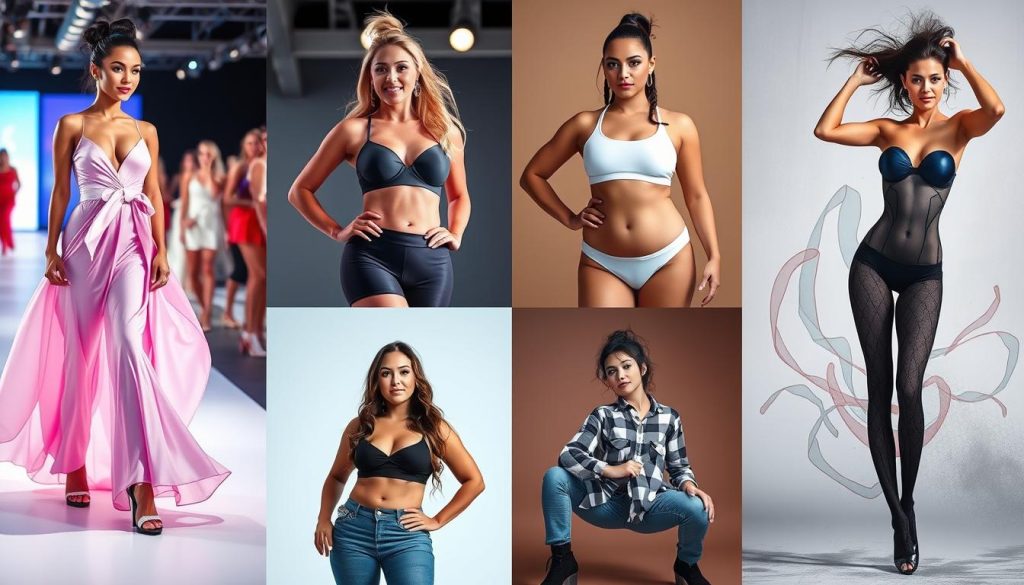Standing before a mirror, practicing your pose, feelings of excitement and nerves mingle. The modelling world’s allure is undeniable, yet it requires dedication and persistence. In Australia, this field is not just about looks; it’s about hard work, adaptability, and understanding the intricacies. Whether your interest lies in fashion, photography, or commercials, knowing the right tips and obtaining sound advice are pivotal in navigating this competitive realm.
Here, we will delve into critical insights crucial for your modelling career. We’ll cover the importance of a compelling portfolio and the intricacies of auditioning. While the pathway may be tough, the correct knowledge and mindset can turn your aspirations into reality. Prepare to embark on the journey into your future on the runway.
Key Takeaways
- Collaboration with novice photographers is a common method for building modelling portfolios.
- A strong portfolio is often the deciding factor for modelling agencies and clients.
- Different modelling types—including plus-size, mature, and male models—are in demand across various industries.
- Models benefit from using professional images over filtered social media shots to enhance their portfolios.
- New faces in the industry receive valuable guidance from specialised bookers at modelling agencies.
- Understanding your measurements and how they align with industry standards is essential for success.
Understanding the Modelling Industry
The modelling industry presents a dynamic world. It’s where individuals use their appearance to endorse brands and artistic concepts. Starting a modelling career can be thrilling yet demands commitment. As you delve into this field, you encounter segments like fashion, beauty, and fitness modelling. Grasping the essentials of the industry aids in navigating its intricacies.
In Australia, the modelling scene is influenced by its diverse population. About one quarter of Australians were born abroad, introducing varied cultural impacts. With nearly 20% speaking a non-English language at home, diversity is now more visible in modelling. Agencies are slowly adopting inclusivity, showcasing models from various ethnic backgrounds, sizes, and ages.
However, stringent height and age criteria by some agencies can restrict opportunities for newcomers. Certain agencies set a cut-off at 20 years for female models, disproportionately affecting them compared to males. The traditional Australian beauty archetype is evolving from the tall, blonde ideal.
Social media’s rise has revolutionized entry paths into modelling. An online presence can bypass the need for traditional agencies, enhancing accessibility. While the embrace of individuality marks this era, the industry still predominantly favors a narrow standard of beauty.
Today, brands look for models who embody genuine stories and drive social change. The curve modelling sector has seen significant growth, mirroring a demand for diversified body types. Fitness modelling too is burgeoning, thanks to brands like Lorna Jane championing it.
| Modelling Types | Key Features | Industry Trends |
|---|---|---|
| Fashion Modeling | High-end fashion shows and campaigns | Greater diversity in model representation |
| Beauty Modeling | Focus on skincare and makeup products | Increased demand for a variety of looks |
| Fitness Modeling | Promotes healthy lifestyles and activewear | Surge in activewear brand collaborations |
| Alternative Modeling | Unique looks with tattoos or piercings | Growing interest from niche brands |
| Promotional Modeling | Engagement at events and customer interaction | Essential for brand representation |
Types of Modelling to Consider
Exploring types of modelling opens up diverse career paths. Every sector is defined by its unique artistic and commercial demands. This variety lets models choose paths that resonate with their interests and strengths.
Fashion modelling is highly prestigious, favoring tall, slender figures to meet its strict standards. Heights above 5’9″ are usually preferred, particularly for runway modelling. In these events, designers display their collections. Models here must comply with specific weight and size criteria, embodying the brand’s ethos.
Commercial modelling, on the other hand, is more inclusive, accepting a range of heights, sizes, and ages. It thrives in advertising, offering models chances to work with various products and clients. Its flexibility compared to fashion and editorial modelling means more job opportunities, fostering a robust career.

There are also niche areas like fitness modelling, swimsuit modelling, and parts modelling. Fitness models spotlight health and strength, appealing to active lifestyle brands. Swimsuit models cater to summer wear aesthetics, whereas parts models focus on particular body parts, like hands or legs, for different campaigns.
The fashion industry is the largest employer of models, presenting both challenges and rewards. Aspiring models must evaluate their attributes and interests when selecting a modelling path. This strategic approach will refine your portfolio and improve your attractiveness in this dynamic industry.
Modelling, What you need to know!
Embarking on a modelling career transcends mere aesthetics. It demands a robust foundation in modelling essentials. These include knowledge of photoshoots, casting calls, and a professional demeanor. The glamour in ads is the result of immense dedication. Many newcomers face financial hurdles initially.
Diverse modelling avenues like fashion, commercial, and swimsuit/lingerie offer opportunities to different talents. Initially, models often work for minimal compensation. Their financial rewards grow with their experience in the industry. Formal qualifications are secondary to traits like diligence, confidence, and adaptability for success.
The industry now prioritizes diversity and inclusivity, changing selection criteria. Though runway models typically meet certain height standards, this is changing. An impressive portfolio acts as a key differentiator. It highlights your distinctive abilities and professional journey.
Building a Strong Modelling Portfolio
A well-crafted modelling portfolio is crucial for your career. It should showcase your finest work and fit the modelling path you’re aiming for. Quality is key when choosing photographs. High-quality images show your professionalism and ability within the industry.
Importance of Quality Images
For new models, having 6 to 12 professional photos in your portfolio is essential. Include various shots like headshots, mid-shots, and full-body pictures. Feature around three different outfits to showcase versatility. Evaluate your photos, discarding any below a score of 7.
How to Collaborate with Photographers
Working with photographers is vital for a standout portfolio. Engage in Trade for Print (TFP) sessions for mutual benefits. Look for photographers experienced in capturing different styles and locations. This will show the breadth of modelling you can do, such as editorial and commercial.
Using Social Media Effectively
Social media is key for models to gain visibility and network. Regularly post professional images, tagging photographers and employing hashtags to broaden your reach. Connect your social media to your portfolio for more insights into your versatility. A strong online presence helps attract modelling agencies.

| Portfolio Aspect | Recommendation |
|---|---|
| Number of Photos | 6 to 12 high-quality images |
| Outfits | 3 different outfits to showcase |
| Photo Types | Headshots, mid-shots, full-body shots |
| Photo Rating | Rate and keep photos scoring 7 or above |
| Portfolio Formats | PDF and physical copies like hardcover books |
Navigating Castings and Auditions
Starting a modelling career means exploring the unpredictable casting and audition scene. Knowing what these events entail boosts your confidence and impact. It’s not just about showing your skills but also about leaving a strong impression. In the often chaotic casting settings, adopting the correct strategy can help you shine.
What to Expect at Casting Calls
At casting calls, the experiences vary widely. You might wait from a mere 10 minutes to over an hour for your turn. Hence, arriving a bit early, around 10 to 15 minutes, lets you get comfortable and assess the environment.
Be prepared to share key details like your agency, contact information, age, and measurements. If you’re under 18, bringing a parent or guardian is necessary. Dress code advice leans towards minimal makeup, fitted clothes, and neutral nails, aiming for a professional demeanour. How you carry yourself and your confidence are decisive in making a memorable impact.
Preparing for Auditions
Getting ready for auditions involves both your mind and body. Practising your poses or runway walk enhances your presentation. Knowing the brand or agency’s style helps tailor your look to fit their preferences, boosting your odds of being chosen.
Carrying a diverse portfolio with headshots and full-body photos is beneficial. Display yourself with assurance, as this increases your noticeability. A positive mindset can make a significant difference. Sending a thank-you email post-audition keeps you in mind for future opportunities.
| Aspect | Impact on Casting Success |
|---|---|
| Arrive Early | Prepare and observe others; 10-15 minutes preferred |
| Dress Code | Simple, fitted clothes increase shortlist chances by 25% |
| Portfolio Quality | Diverse photos improve selection likelihood by 35% |
| Posture and Confidence | Enhances memorability; a key trait for successful models |
| Positive Attitude | Increases selection probability; avoid negativity |
| Thank-You Follow-Up | Boosts recall chances by 60% for future projects |
Essential Skills and Training for Models
Key modelling skills are crucial for success in the dynamic fashion industry. Engaging in diverse training sessions is vital. It helps you learn important posing techniques and effectively engage your audience during photoshoots. These educational opportunities can greatly improve your skills.
Developing Posing Techniques
Mastering effective posing techniques is essential for aspiring models. Practicing in front of a mirror is beneficial. It ensures you look confident and natural on camera. Modelling schools offer structured programs to perfect these skills.
Taking Acting and Movement Classes
Acting classes can take a model’s performance to new heights. These courses teach emotional expression and style versatility for various projects. This training enhances adaptability to different designer expectations and themes.

Maintaining Your Physical Appearance
In the modelling industry, success hinges on maintaining a specific look. Cultivating a disciplined routine for fitness and diet is crucial. This not only boosts your health but also meets industry expectations. Moreover, a committed skincare regimen polishes your image, enhancing your appeal to clients.
Importance of Fitness and Diet
Your body is your most significant asset in modelling. A healthy, nutrient-rich diet supports your wellbeing and boosts your appeal. Regular workouts shape and tone your body to industry standards. A mix of cardio, strength training, and flexibility exercises offers a balanced fitness approach. Here are some essential elements:
- Hydration: Staying hydrated is key for skin elasticity and health.
- Balanced Meals: Focus on vegetables, lean proteins, and whole grains.
- Consistent Exercise: Target at least 150 minutes of activity weekly.
Skincare and Grooming Tips
While fitness is critical, effective skincare is just as crucial for appearance. Choosing the right skincare for your type prevents blemishes and dryness. Here are some top skincare tips:
- Cleansing: Use a gentle cleanser to clear impurities and oil.
- Moisturising: Daily hydration keeps your skin looking fresh.
- Sun Protection: Always wear sunscreen to guard against UV damage, even on cloudy days.
Strong skincare habits, combined with regular fitness, boosts your marketability. Taking care of your body and skin is crucial for your career in modelling.

| Fitness Routine | Benefits |
|---|---|
| Cardiovascular Activities | Boosts stamina and heart health |
| Strength Training | Improves muscle tone and definition |
| Flexibility Workouts | Enhances motion range and lowers injury risk |
Understanding Modelling Contracts and Rates
Entering the modelling industry requires knowledge of contracts. These documents define crucial details like usage rights, contract length, and payment rates. Comprehending these components lets you make wise choices and defend your rights.
Bear in mind, your starting rates might not meet your expectations. With a growing reputation and a stronger portfolio, you’ll have room to negotiate better pay. Average commissions range from 10% to 20% of your earnings. Mother agencies generally take a 10% to 15% cut from commissions on jobs via other agencies.
High commissions over 20% could signal dishonesty. Any agency urging fast contract signings without proper review should be approached with caution. Contracts should clearly mention conditions for termination to avoid later disputes.
Legit agencies usually cover costs for test shots and portfolios, avoiding upfront fees. If a contract asks for money upfront, think twice. It could be a scam.
Ensure contract terms support your career aims. Sometimes, models are bound by excessively long contracts, limiting future prospects. Ideal contracts span between one to three years, granting you career flexibility.
Getting legal advice before agreeing to a contract can protect your interests. A deep understanding of contract subtleties, including exclusive rights and agency obligations, is crucial for your success.

| Contract Element | Details | Red Flags |
|---|---|---|
| Commission Rates | 10%-20% for regular agencies; 10%-15% for mother agencies | Rates above 20% may lack transparency |
| Contract Duration | Typically 1-3 years | Excessively long terms limit flexibility |
| Upfront Fees | Legitimate agencies cover costs without upfront payments | Requests for upfront fees may indicate scams |
| Termination Clauses | Should be clear and specific | Ambiguity can create confusion |
Networking and Building Industry Connections
Effective networking is crucial for a successful modelling career. It opens doors to many opportunities by linking you with the industry. At workshops and events, you connect with professionals and other models. Together, you share skills and experiences, enhancing each other’s portfolios.
Attending Workshops and Events
Modelling workshops and events dramatically expand your network. A notable 76% of professionals consider the right connections essential for career progression. These events offer opportunities to meet:
- Collaborators like photographers and designers.
- Recruiters searching for new talent.
- Industry veterans with valuable insights.
Connections made here are invaluable. Remarkably, 31% of job seekers secure positions through referrals. By participating, you uncover hidden opportunities.
Collaborating with Other Models
Collaboratively working with other models reaps numerous benefits. Such partnerships lead to:
- Exchanging resources, including portfolio images.
- Developing joint projects to showcase diversity.
- Fostering a supportive community for growth.
Expanding your network to include various contacts provides insight into the industry. It also opens doors to job opportunities. The more diverse your connections, the better your career prospects.

| Networking Benefits | Description |
|---|---|
| Strengthens Connections | Creates a strong network for potential long-term partnerships. |
| Increases Visibility | Enhances your presence and brand in the industry. |
| Access to Job Opportunities | Opens channels to jobs through referrals. |
| Career Support | Provides career advice and mentorship from experienced individuals. |
| Builds Confidence | Promotes a sense of industry belonging. |
Strategic networking can revolutionize your modelling career. Connecting with peers and professionals sets a strong foundation for lasting success.
Facing Rejection and Building Resilience
Rejection is a common challenge in the modelling industry, testing even the strongest wills. Every model has faced this tough reality, regardless of their level of success. Learning to deal with rejection is key to growing in this competitive field. It’s important to remember that rejection is usually not personal, which helps maintain clarity and perseverance.
The journey to resilience is paved with obstacles that must be confronted bravely. Take Thomas Edison, for instance, who endured 10,000 failures before inventing the light bulb. This demonstrates how persistence can result in remarkable breakthroughs. Similarly, J.K. Rowling faced countless rejections before “Harry Potter” was finally accepted, showing the value of determination.

- Acknowledge your emotions: It’s crucial to recognize the impact of rejection on your emotional well-being to foster growth.
- Seek constructive feedback: After facing a setback, constructive criticism is vital for improving your skills.
- Reframe rejection: Look at rejection as a chance for improvement, pushing you further in your career.
- Practice self-care: Taking care of yourself is crucial, especially during challenging times.
Olympic champion Michael Phelps highlighted the importance of support and self-care. Adopting a growth mindset transforms rejection from a perceived failure to a stepping stone for success. As you move through the modelling world, remember that resilience is built through overcoming challenges, ultimately setting the stage for greater achievements.
Future Trends in the Modelling Industry
The modelling industry is transforming significantly as we move towards 2024. It’s vital to be aware of new trends for career success. Adapting to these changes opens up new opportunities that match evolving consumer desires.
It’s essential to maintain a diverse and current portfolio. This demonstrates your market relevance and showcases your adaptability. Try out various themes, styles, and locations in your photoshoots to add depth. Regular feedback from agencies will ensure your work meets industry trends and standards.
Networking is crucial in the modelling scene. Forming connections can lead to mentorships and important career insights. Engage in industry events, fashion shows, and workshops to find mentors to guide your path.

Diversity and inclusivity now lead in the modelling future. There’s a growing demand for models of all shapes, sizes, and backgrounds. This shift offers more opportunities for those who defy traditional beauty norms.
Digital modelling is revolutionising the field. The growth of influencers and social media presents a new challenge to navigate. Meanwhile, environmentally friendly practices by brands are making eco-conscious models more desirable.
Authenticity is increasingly important. Models who are true to themselves are drawing more interest. The development of virtual reality and 3D printing could dramatically change scouting and employment methods.
| Trend | Description | Opportunity |
|---|---|---|
| Diversity and Inclusivity | Demand for models of all shapes, sizes, and ethnicities | Expand portfolio to include diverse representations |
| Digital Modelling | Rise of influencers and social media presence | Leverage social platforms for personal branding |
| Sustainability | Focus on eco-friendly practices by brands | Align with brands advocating for sustainability |
| Authenticity | Value placed on unique personalities | Showcase individuality to attract attention |
| Technology Advancements | Virtual reality and 3D printing innovations | Stay updated on tech trends for scouting |
Tips for Aspiring Models to Succeed
Succeeding in the competitive modelling industry demands determination and strategy. To boost your visibility, remain passionate and pursue continuous learning. Participate in workshops and classes to sharpen your skills and boost your confidence before the camera. Competitive events are key for showcasing your talent, improving your industry presence, and building valuable connections. Networking plays a crucial role; fostering relationships across varied platforms and events can unlock new opportunities.
Your portfolio is vital for career navigation; prioritize creating a collection of diverse, high-quality images. It’s essential to invest in professional photography that captures your unique traits. Moreover, an active social media presence is critical for success in modelling today. It lets potential clients discover your talent while promoting your work. Producing quality content and engaging genuinely with your audience can enhance your profile and offer insights into the modelling success.
Understanding rejection is an inevitability in modelling is crucial. Resilience and professionalism help overcome challenges that come with the territory. View this as a journey where a solid beauty regime, active lifestyle, and dedication are your allies. Embracing model career advice like practicing poses daily and prioritizing self-care will aid in achieving longevity and success in this dynamic field.


